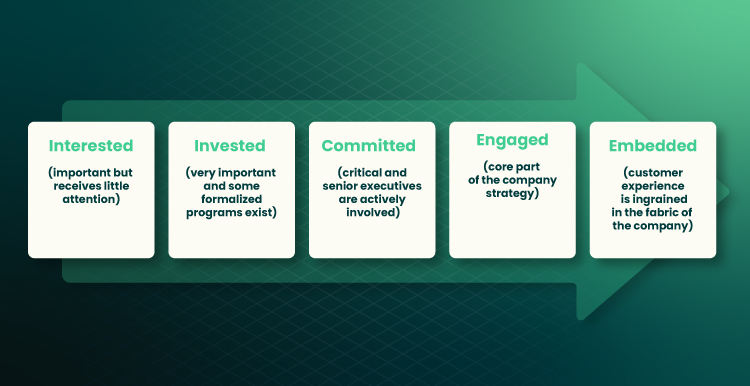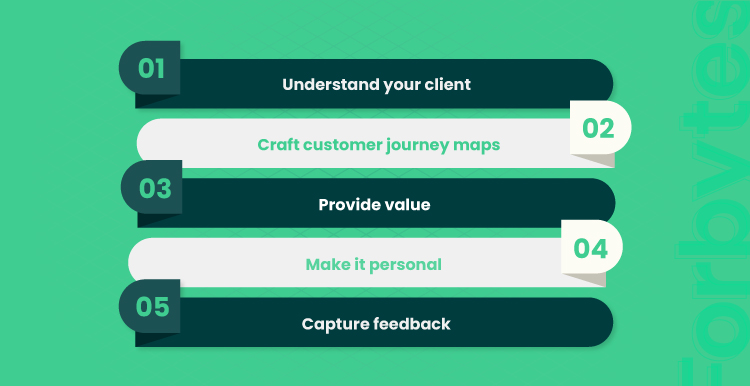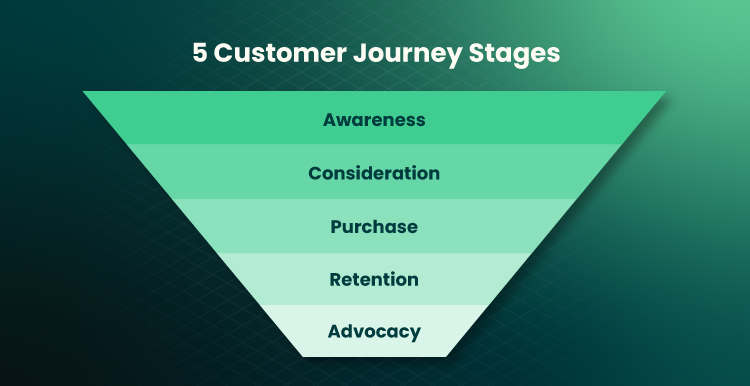Happy customers spend more. To be precise, 140% more. To grow your sales, you need to care about customer experience and incorporate data to manage it effectively. The knowledge from cognitive sciences plus data analytics and solid marketing strategy can help you reach this goal.
In this article, we are going to discuss customer experience management. We’ll also give you a piece of advice on how to run your customer-focused duties effectively.
What Is CXM?
Stats show: 12 positive customer experiences will make up for 1 negative. This means that when you fail to offer a good CX, you’ll have to invest 12 times more to make up for it. The biggest mistake in marketing is to think that you know enough about your client. Knowing when they have a birthday or when there’s an anniversary with your company is far from enough. The quality of customer experience depends on how well you know your audience. This is seen in the all-encompassing client data that you collect, manage, and use for decision-making. If you offer optimum client experience, you start earning more. 90% of customers reveal their eagerness to interact with a brand if its customer service rate is high.
Diving deeply into customer needs and pains enables you to know for sure what client challenges can be solved with your product and how. This, in turn, opens new revenue channels for your organization and makes your customer routine overall pleasant. 86% of customers report the willingness to pay more for a good user experience. This means that putting effort into pleasing your client pays off in the form of increased sales and a better market reputation.
But what is customer experience and how can I use it to grow customer loyalty? CXM stands for customer experience management. This area covers the analysis of client interactions with a company, evaluation of their satisfaction level, and the use of data to find areas for improvement and drive better customer experiences. The latter consists of both conscious and unconscious perceptions of your products and company. Customer experience begins with the first impression of your company. Based on the customer experience strategy, you build a consistent relationship between you and your client.
The three main requirements of a good CXM include:
- Senior leadership. The overall strategy of building relationships with a client is shaped by senior leadership. Senior-level executives are responsible for making strategic decisions that influence client satisfaction.
- Cross-channel exposure. A look at client retention has to be consistent and include the cross-channel analysis of client exposure. The moment when a customer buys from you is not the only thing that’s worth considering. Customer engagement on the website, positive and negative feedback, social media interactions, and other types of qualitative data are valuable sources of client insights as well.
- End-to-end data analysis. You should include all the interactions possible in the analysis of customer satisfaction. This will give you a consistent understanding of the gaps to be solved to improve the user satisfaction rate. All-encompassing data analysis will lead to more informed decisions and practical customer insights.
CXM vs BXM
CXM: Customer Experience Management. It covers all the interactions of a client with your organization. When thinking about CXM, many people imagine the process of making a purchase only. But in reality, CXM is more complex and includes all the interactions possible. This, for example, is client interaction with you on social media, their experience from communicating with a chatbot, their impression from the support team, and more. The process of making a purchase is important as well. But we shouldn’t underestimate the power of other types of interaction to shape client decisions on whether to remain loyal or go to a competitor.
BXM: Brand Experience Management. This is managing feelings, impressions, and ideas that come from brand-focused interactions with your company. Brand experience management and customer experience management often overlap. But for a brand-focused experience, you need to make customer touchpoints brand-medicated and personalized. There has to be your unique branded story present at each stage of client involvement. The difference between CXM and BXM lies in the focus as well. In CXM, you hear your client’s story. In BXM, you tell your own story.
CXM vs CRM
CXM: Customer Experience Management. It is a holistic and customer-centric approach that involves strategies and techniques to nurture your clients and encourage them to stay with you for a long. Customer experience defines the company’s overall strategy and positioning in the market.
CRM: Customer Relationship Management. Compared with CXM, CRM has a narrower function. It’s mainly used by the teams who interact with a client for marketing and sale purposes. The main goal of robust CRM is to convert a user into a customer. Whereas the goal of CXM is to make a person interacting with your company happy regardless of the conversion stage.
Why Is CXM Important?
You need effective CXM practices at work not only for good PR. Every department and every aspect of your company should function with the end user in mind. Putting clients first gives you a competitive advantage. It helps you set the emotional connection with your audience. If clients feel they are valued and appreciated, they are more eager to respond with loyalty and dedication as well. And vice versa, if a client has a negative experience with your brand, they are 80% likely to go to a competitor.
By the end of this year, CX spending worldwide will reach $640 billion. Improving your CXM is a win-to-win solution. You deliver personalized experiences to your business customers. Your company gets a loyal audience and high conversion rates. You get data at hand to clarify what affects your client’s behavior, what habits a particular client segment has, and more. In general, we may talk about the following CXM benefits:
- Insightful work. Good customer experience management gives you many insights into your client. You get to know each client segment better and offer a personalized experience to each category of users.
- Increased client loyalty. Personalized experience will increase customer retention and boost other ecommerce metrics. You can learn more about your target audience and segment them in more detail. Customer experience data are used for crafting effective marketing campaigns and ads. These, in turn, help you grow the number of loyal customers.
- Competitive advantage. When you increase customer satisfaction, they choose you over the competitors. In the competitive environment, word-of-mouth recommendations play into your hands. Satisfied clients bring you new customers. This means that you’ll need to spend less on client acquisition.
- Measurable results. Data-driven decision-making helps you shape a more consistent and goal-oriented strategy for your business. Data extracted from the knowledge you have about your client gives you useful clues on how to improve your business outcomes and scale.
- Motivated team. Knowing what your client needs to feel satisfied translates into clear goals and tasks for your team. There’s a strong link between customer satisfaction and employee experience. Satisfied clients motivate employees to perform well. This results in positive and friendly interactions.
The following scheme presents different levels of a customer-centric business strategy. If you are only at the start, it’s highly recommended to reevaluate your strategy and dive deeper into customers’ expectations. This will help you retain customers and increase customer loyalty.
Customer Experience Management Challenges
When it comes to customer experience management (CXM), it’s easier to say than do. Companies face many ecommerce challenges, including:
- Investment. To extract value out of data, you’ll need tools to collect these data. Software product engineering is a costly process that requires you to spend time and resources on your goals. To get a quality product at a reasonable price, we recommend choosing from 3 outsourcing types. Eastern European countries like Ukraine or Poland have a lot to offer in terms of tech expertise.
- Internal communication. All key stakeholders need to have real-time access to customer data. The marketing communications, customer support, and sales departments have to work hand in hand to reach better results. Those who daily interact with a customer should be actively involved in brainstorming sessions.
- Lack of omnichannel strategy. To provide a flawless user experience, you need to establish end-to-end communication with clients. Use their feedback in decision-making. When the communication chain is interrupted at a particular stage, you lose valuable data. Such data has to be gathered across all of your channels. These include ecommerce website metrics, social media, chats with the support team, phone calls, and so on.
5 Steps for Building a Great CXM Strategy
These are the essential steps for you to build a good customer experience management strategy.
- Understand your client. No one is the same. That’s true. But still, some similarities help group clients into categories. These are called client personas (or customer profiles). They represent your typical client segment from your customer base. The common characteristics shared by one client persona can be their age, budget, occupation, interests, customer preferences, challenges, etc.
- Craft customer journey maps. Customer journeys are the replication of the path a client goes through when interacting with a brand. It has to include all the touchpoints where a customer interacts with your company. When you craft a customer journey, you can anticipate challenges and prevent them before a client feels dissatisfied. Clues you’ll get when building goal-centric customer journeys for different segments will move you closer to designing a positive customer experience.
- Provide value. 90% of US consumers state that customer experience is a defining factor in their decision to engage with a company. Your task is to make a customer remember you. For this, you need to set an emotional connection with your audience. Provide your customers with the extra value they won’t get from your competitor. Create customer-centric content that will help your client solve their consumer challenges. For example, if you are an apparel retailer, posting an article on top fall fashion trends in 2022 or sending them email tips on a capsule wardrobe will be a good idea. Giving extra value will help you build relationships with your clients.
- Make it personal. As a consumer, a client visits your ecommerce website with a certain goal. Sometimes, this goal is to make a purchase. But more often, it’s to conduct their research and compare you with competitors. This is why you need to personalize the customer experience and use the content to demonstrate the value. Personalized experience appeals to a client and enhances post-purchase relationships. This, in turn, increases client retention and drives more sales.
- Capture customer feedback. Capturing customer feedback allows you to improve your entire organization. Client demands are rising, and you need to know how to satisfy them at the right time and in the right way. Historically, companies tend to gather structured data from clients. For example, their demographics or completed questionnaires. However, having such data is not enough to build a truly personalized story. You should have a 360-degree view of your client, and this is where business intelligence comes in handy. BI tools for managing customer experience and customer analytics software are capable of gathering unstructured data across your channels. You get the chance to use the customer voice to upgrade your strategy and keep track of the changing market. You get to know what the existing customers say of you on social media or other websites and how they perceive your brand in general.
CXM Software. How It Can Be Used to Personalize Client Interactions?
Customer experience management helps you build a consistent strategy for customer interactions. CXM software is a tool that eases your cross-department work on client nurturing. With its help, you’ll collect and manage insightful data. These data can be used for crafting personalized stories and attracting new audiences. Customer experience management software comprises the following functionality:
Content management
Content management opens access to knowledge management. By integrating useful content into your services, you get to know what engages your client the best. Some audience segments may react better to email messages. Others have more time to complete your surveys, and so on. Collect feedback from your audience. Based on the feedback on your content, you will know when it’s the right time of the day to get in touch with your client and what type of content produces the best return.
Customer relationship management
Your customer experience management system can have such functionality or be integrated with on-premises CRM software. Customer relationship management functionality will be used by your sales and marketing teams to perform detailed customer segmentation and address the right segments for the right goals.
Data Analytics
Collecting numbers is the start of the way to successful customer experience management. Knowing how to use them for making predictions is much more effective. Data analytics integrated into CXM software will help your team predict changes in client sentiment and respond accordingly. Key driver analysis, statistical analysis, and natural language processing technology are used to drive insights from data. For example, you may track how NPS (Net Promoter Score) changes after you add something new to marketing.
Marketing automation
Marketing automation streamlines the mundane jobs of your team. With its help, they will automatically manage marketing campaigns in different channels, including websites, email, social media, and more. For example, sending client satisfaction surveys after the purchase or triggering a customer that stays on your website for a long by sending them a personalized discount offer.
Personalization engines
Personalization engines are the type of software that enables marketers to drive personalized client experience based on their location, intent, past interactions, etc. Personalized content automatically distributed across different client segments lies at the core of personalization engine software. It’s used to attract client attention based on their current need and offer the solution by your brand.
Customer journey orchestration
Do you see your business goal in encouraging clients to make a purchase? That worked ten years ago. But now, you need a more consistent strategy for client interactions. The entire customer journey involves several stages. It starts with an awareness of your brand, consideration of you in front of competitors, and making a purchase. Then, the most complicated part of the customer lifecycle starts. This is client retention and advocacy. A loyal customer will bring you more than a one-time visitor. Investing in client retention and ensuring a flawless post-purchase experience is as vital as engaging your audience at the start.
A quality customer experience management solution allows for customer journey orchestration. It helps you shape a consistent view of your brand in the client’s eyes and decrease customer churn. Depending on the stage of the customer journey, the software will help fulfill customer expectations. You’ll bridge the gap between client expectations and service delivery and get a much deeper understanding of how to use your offer to put the client first. This will drive brand loyalty and increase the number of satisfied customers.
Customer service management
With a CXM tool, you’ll get the opportunity to manage omnichannel customer communication. This goes beyond customer support calls. A powerful customer experience management system will open access to call analytics, call routing, and role-based reporting. What’s more, HubSpot research shows that 90% of customers expect you to provide an “immediate response” to their query. They expect you to respond in 10 minutes or less. Otherwise, a business is at risk of losing a prospective customer.
Data visualization and dashboards
Data visualization eases human perception of what’s happening in a company. A good customer experience management software provides the opportunity to visualize data. For this, you can launch role-based dashboards. This means that employees will see data based on their role in a company. A data-centric approach to decision-making will facilitate their cooperation and help them focus on their job goals.
Ticketing and notifications
This function is essential for reacting to issues promptly. The system is capable of notifying the right people about the problem, question, or request. Automated notifications on the workflow will also be useful for your team’s cooperation. They will be able to synchronize their effort targeted on a client and build a robust interaction strategy.
Closing Remarks
This is all we want you to know about client experience management. The main insight from this article is that CXM software can be a truly helpful tool when you fail to look at your business from a bird’s eye view. You may wonder how to build or choose the best. For this, answer the following questions:
- Does your software provide you with access to real-time customer data?
- Is the system compatible with the software you already use?
- Does it give you personalization clues?
- Does your system work on the omnichannel approach?
- Is your customer information secure and well-protected from third-party breaches?
If you choose an on-premises solution, the answer to all these questions should be “yes.” And if you think that it’s the right time to build a custom, need-tailored, and highly secure system, contact our team. With 10+ years of experience in ecommerce development, we’ll be happy to help you make your customers happy!

Our Engineers
Can Help
Are you ready to discover all benefits of running a business in the digital era?

Our Engineers
Can Help
Are you ready to discover all benefits of running a business in the digital era?











